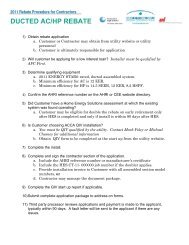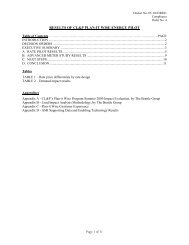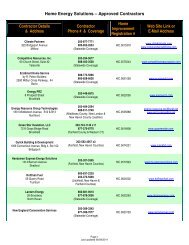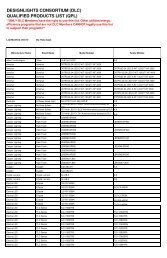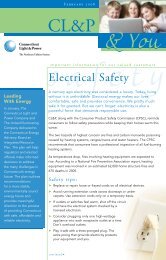Opinion - Northeast Utilities
Opinion - Northeast Utilities
Opinion - Northeast Utilities
Create successful ePaper yourself
Turn your PDF publications into a flip-book with our unique Google optimized e-Paper software.
Docket No. 424 - Interstate<br />
<strong>Opinion</strong><br />
Page 8<br />
The Willimantic South Underground Variation would have consisted of 10.7 miles underground cables mostly<br />
beneath or along roadways. The variation would cross several wetlands and watercourses (including seven vernal<br />
pools and one amphibian breeding habitat). The variation would have cost $266.1 million more than H-frame<br />
structures and a vertical line configuration on the federal property in the Mansfield Hollow area. On account of<br />
the adverse environmental effects of this variation, as well as the costs, the Council did not approve this variation.<br />
The cost associated with installation of any underground alternative would impose an unreasonable economic<br />
burden on Connecticut ratepayers. In addition, none of the underground variations would result in a significant<br />
overall reduction of Electric and Magnetic Fields.<br />
Once the Council ruled out undergrounding, the alternatives remaining for consideration were the Brooklyn and<br />
Willimantic South overhead variations, the three Mansfield Hollow Configurations, and the Hawthorne Lane<br />
alternative. The Council selected the Hawthorne Lane alternative provisionally and left the Mansfield Hollow<br />
Configurations to be decided later: all of these are discussed in the section of the <strong>Opinion</strong> that presents the final<br />
route.<br />
As to the Brooklyn Overhead Variation, it was designed for a new “greenfield” corridor that would have extended<br />
3.3 miles through forested land, lawn areas associated with residences, and agricultural fields. It also would have<br />
disturbed 4.4 acres of wetlands. On account of the environmental effects associated with greenfield development<br />
and its high cost, the Council did not approve this variation.<br />
As to the Willimantic South Overhead Variation, it would have involved an 8.6-mile new corridor and a short<br />
length of 15-foot ROW expansion in width, both designs requiring easements from private landowners. It would<br />
have crossed 15 watercourses and 22 wetlands, two Connecticut State Parks, and property owned by the Fin, Fur<br />
and Feather Club, Inc. Its cost would have been approximately $9-$10 million more than the Mansfield Hollow<br />
configuration it would have replaced. On account of the adverse environmental effects of this variation, as well as<br />
the costs, the Council did not approve this variation.<br />
Having carefully reviewed this wide range of alternatives and variations, the Council determined that the<br />
overhead facility as proposed is the most cost-effective and appropriate, in terms of both its capital and life-cycle<br />
costs, is consistent with the purposes of the Public <strong>Utilities</strong> Environmental Standards Act (PUESA), and is<br />
consistent with the regulations and standards adopted pursuant to Connecticut General Statutes § 16-50t.<br />
V. Environment<br />
The northeast corner of Connecticut is mainly rural in character, with scattered, small neighborhoods, agricultural<br />
fields, woods, and abundant water resources, including associated wetlands. The existing overhead transmission<br />
lines have been a familiar part of this landscape for decades, and in several areas farmers are cultivating fields<br />
beneath them on the ROWs. The Council judges that the least environmental disturbance would come from<br />
developing Interstate generally alongside the existing lines, as proposed, instead of either diverging from the wellestablished<br />
route into new territory, or adding a new underground cable system—whether whole or in pieces—<br />
that would impact sensitive environmental resources the overhead facility currently spans. Nevertheless, the<br />
Council acknowledges that any new construction will have numerous temporary and some permanent<br />
environmental impacts, and will assure that these are minimized.



